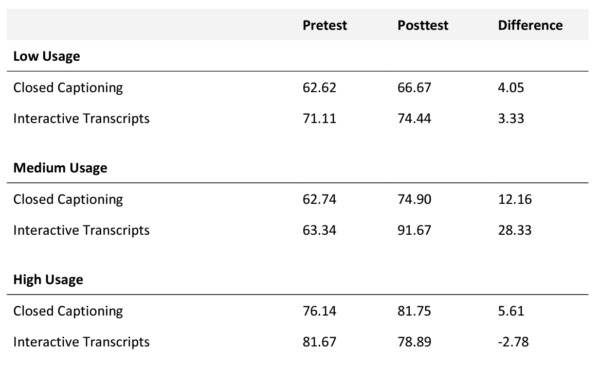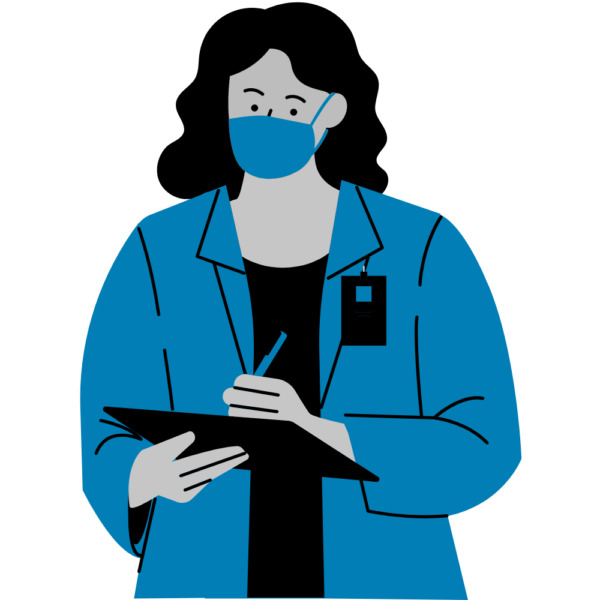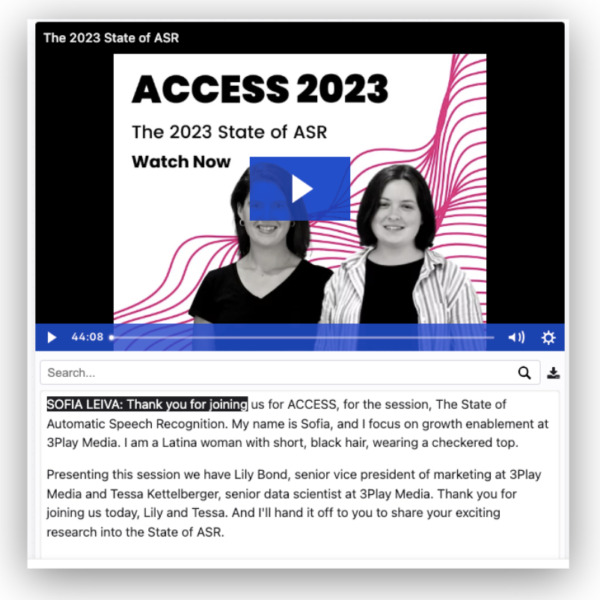Why Continuing Medical Education (CME) & Other Medical Training Videos Need Captions
ROI Analysis of Transcription & Captioning [Free eBook]
Whether it’s a medical device training video, instructional surgery guide, or continuing medical education (CME), captions and transcripts have become invaluable to the medical and healthcare industries.
Captions are crucial for enhancing learning outcomes, meeting accessibility standards, and ensuring equitable access to vital medical information. In this blog, we will explore why captions are necessary for medical training video content, the challenges faced when implementing them in medical and healthcare videos, and how 3Play Media helps make medical video content more accessible and engaging.
Why Are CMEs, Medical Device Companies, and Other Healthcare Video Publishers Captioning Their Training Content?
Continuing medical education (CME), medical device companies, and other healthcare/medical organizations are prioritizing captions for their video content for a couple of key reasons: to support learning, engagement, retention, and knowledge transferability of information, and to enhance accessibility & meet regulatory requirements
How Captioning Supports Learning & Engagement for Medical Content
It’s no secret that captions and transcripts have been proven to boost learning outcomes, engagement, and retention of information. According to a study by the University of Florida-St. Petersburg (USFSP), 42% of learners reported that captions help them focus and 38% reported that using an interactive transcript helped with knowledge retention. The study also found that the use of captions and interactive transcripts can boost knowledge transferability and application:

Source: USFSP Study
In the medical and healthcare fields, captions and transcripts can be particularly valuable learning tools for professionals who need to learn how to operate and maintain medical devices or require continued education to meet training requirements to maintain their licenses.
Why Closed Captions & Other Accessibility Features Help Medical Organizations Stay Compliant
In the United States, accessibility laws like the Americans with Disabilities Act (ADA) and Section 504 of the Rehabilitation Act require certain medical content to be accessible to people who are D/deaf or hard of hearing. That means accurate, readable captions and transcripts are needed for medical and healthcare video content. Medical and healthcare organizations have a responsibility to comply with applicable accessibility laws and create an ethical, inclusive experience for all.
According to a report published to the Journal of the American Medical Association (JAMA) Network Open, an estimated 7.5% of medical residents have a disclosed disability. Further, researchers found “an association between a lack of accessibility and heightened risk for depression and self-reported medical errors during training. This has important implications for the mental health and retention of disabled trainees, as well as for patient care.”
With an estimated 430+ million people in the world with disabling hearing loss, accurate transcription and captioning of medical videos is necessary to ensure D/deaf and hard of hearing medical professionals receive the same information and training as hearing individuals. It’s important to note that in addition to accessibility, captions also benefit users without hearing loss, including neurodivergent viewers, non-native English speakers, and people who simply prefer media with captions turned on.
What Captioning Challenges Do Medical and Healthcare Companies Face with Their Video Content?
Accuracy
Medical and healthcare content contains a lot of complex terminology and specialized jargon. Getting those industry-specific terms right is a huge priority for medical organizations. For example, the wrong spelling or mistranscribed word on a video demonstrating the use of a medical device can impact how healthcare professionals understand and implement safe usage of the product for patients.
Privacy & Cybersecurity
Because of the nature of the healthcare industry, some medical content may be confidential, or protected by laws like HIPAA. The Health Insurance Portability and Accountability Act of 1996 (HIPAA) safeguards medical information through data privacy and security provisions in the United States. Medical organizations require secure transcription of captions to protect private and/or sensitive information covered under HIPAA and other privacy laws.
Volume of Content
The need for healthcare professionals to stay up-to-date on the latest medical advancements and best practices is increasing. Some medical organizations, especially CMEs, have accumulated libraries of training content for medical professionals to keep up with demand. This content may or may not have been previously captioned before new priorities and content took precedence, leaving a backlog of videos waiting to become accessible. The sheer volume of medical video content can be overwhelming to some vendors who cannot offer scalable solutions for accurate, accessible captions. As a result, organizations are sometimes left with time-consuming options that may not meet their needs.
Workflows
In the interest of saving time, some medical companies may choose to try ASR-only transcription, with varying accuracy results. Without proper oversight, ASR-only transcription can require hours of manual editing for healthcare professionals who don’t have the bandwidth to make corrections on every single caption file. Even for those using highly accurate professional transcription or captioning services, medical organizations can get bogged down with cumbersome captioning workflows from vendors who rely on manual processes. This can make for slower, inconsistent progress toward video accessibility.
Globalization
The global nature of medicine means that organizations must also provide the same training and information for doctors and medical professionals worldwide. Localization of video content, such as the addition of translations, subtitles, or dubbing, is increasingly important to reach all viewers and promote accurate understanding of medical information. For example, when it comes to the training, maintenance, and usage of medical devices, proper localization of videos helps support barrier-free training and instructions.
How 3Play Makes Medical Video Content More Accessible & Engaging
Did you know that 3Play Media captions hundreds of hours of medical content each week? Here’s why medical and healthcare organizations are trusting us with their video accessibility needs:
Guaranteed 99% Accuracy
Our robust pool of professional editors undergo a rigorous certification process, and many are well experienced in transcribing medical and healthcare-related content. At 3Play Media, we guarantee a 99% accuracy rate and build quality assurance (QA) into the process by default. We also offer the ability to preload special instructions, custom word lists, and more on a file-by-file basis or for an entire project. For videos that need some extra attention, we offer options for additional QA and customizations.
Legal Compliance
Our captions comply with all major accessibility laws, including ADA Title III and Title II requirements, and standards established in Sections 508 and 504 of the Rehabilitation Act. 3Play Media is also HIPAA compliant and undergoes annual penetration testing. All staff, accessibility services professionals, and contractors are vigilant to protect privacy and security in all forms—from printed to electronic information.
Simplified Accessibility Through Automation & Integrations
Medical and healthcare professionals don’t need to add more to their plate by coordinating and editing accessibility workflows. We believe that captioning workflows should be as simple as possible. The 3Play captioning process blends professional oversight with our innovative technology to deliver highly accurate captions on time and at scale.
We offer 20+ integrations and APIs to help automate the captioning process. We have the most video platform integrations in the industry, can create custom formats and workflows, and provide flexible APIs that support efforts to centralize the accessibility process at medical organizations.
Engagement Tools to Support Your Audience
In the medical field, interactive transcripts can be particularly useful for CME videos and other educational content by boosting learning success. Students or providers watching a CME video can search for terms in a transcript, play the video from that point in the transcript, and retain more information.
3Play Media’s Access Player enables the ability to publish fully accessible media to a website with no development effort. Add an interactive transcript, SEO embed, audio description, playlist search, and more to any video to enhance your viewers’ web experience.
Full Suite of Accessibility Services
We’re well-known for our captioning and transcription solutions, but we also offer an array of media accessibility services including translation, subtitling, audio description, and more. Whether you are looking to localize your medical video content for global reach, or interested in expanding your efforts to accommodate blind and low vision communities, we’ll work as your partner in accessibility to help future-proof your content.
This blog was originally published by Patrick Loftus on April 20, 2018, as “Captioning and Transcription for Medical Content” and has since been updated for comprehensiveness, clarity, and accuracy.








